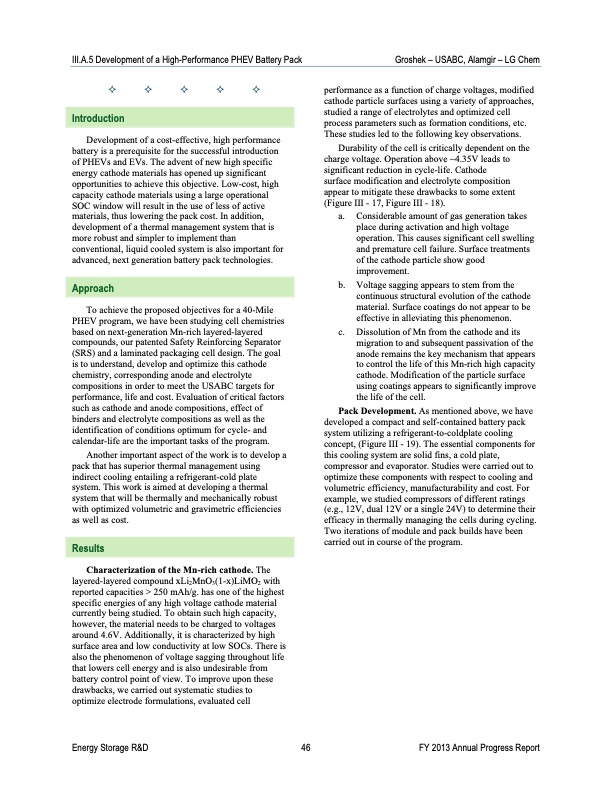
PDF Publication Title:
Text from PDF Page: 024
III.A.5 Development of a High-Performance PHEV Battery Pack Groshek – USABC, Alamgir – LG Chem Introduction Development of a cost-effective, high performance battery is a prerequisite for the successful introduction of PHEVs and EVs. The advent of new high specific energy cathode materials has opened up significant opportunities to achieve this objective. Low-cost, high capacity cathode materials using a large operational SOC window will result in the use of less of active materials, thus lowering the pack cost. In addition, development of a thermal management system that is more robust and simpler to implement than conventional, liquid cooled system is also important for advanced, next generation battery pack technologies. Approach To achieve the proposed objectives for a 40-Mile PHEV program, we have been studying cell chemistries based on next-generation Mn-rich layered-layered compounds, our patented Safety Reinforcing Separator (SRS) and a laminated packaging cell design. The goal is to understand, develop and optimize this cathode chemistry, corresponding anode and electrolyte compositions in order to meet the USABC targets for performance, life and cost. Evaluation of critical factors such as cathode and anode compositions, effect of binders and electrolyte compositions as well as the identification of conditions optimum for cycle- and calendar-life are the important tasks of the program. Another important aspect of the work is to develop a pack that has superior thermal management using indirect cooling entailing a refrigerant-cold plate system. This work is aimed at developing a thermal system that will be thermally and mechanically robust with optimized volumetric and gravimetric efficiencies as well as cost. Results Characterization of the Mn-rich cathode. The layered-layered compound xLi2MnO3(1-x)LiMO2 with reported capacities > 250 mAh/g. has one of the highest specific energies of any high voltage cathode material currently being studied. To obtain such high capacity, however, the material needs to be charged to voltages around 4.6V. Additionally, it is characterized by high surface area and low conductivity at low SOCs. There is also the phenomenon of voltage sagging throughout life that lowers cell energy and is also undesirable from battery control point of view. To improve upon these drawbacks, we carried out systematic studies to optimize electrode formulations, evaluated cell performance as a function of charge voltages, modified cathode particle surfaces using a variety of approaches, studied a range of electrolytes and optimized cell process parameters such as formation conditions, etc. These studies led to the following key observations. Durability of the cell is critically dependent on the charge voltage. Operation above ~4.35V leads to significant reduction in cycle-life. Cathode surface modification and electrolyte composition appear to mitigate these drawbacks to some extent (Figure III - 17, Figure III - 18). a. Considerable amount of gas generation takes place during activation and high voltage operation. This causes significant cell swelling and premature cell failure. Surface treatments of the cathode particle show good improvement. b. Voltage sagging appears to stem from the continuous structural evolution of the cathode material. Surface coatings do not appear to be effective in alleviating this phenomenon. c. Dissolution of Mn from the cathode and its migration to and subsequent passivation of the anode remains the key mechanism that appears to control the life of this Mn-rich high capacity cathode. Modification of the particle surface using coatings appears to significantly improve the life of the cell. Pack Development. As mentioned above, we have developed a compact and self-contained battery pack system utilizing a refrigerant-to-coldplate cooling concept, (Figure III - 19). The essential components for this cooling system are solid fins, a cold plate, compressor and evaporator. Studies were carried out to optimize these components with respect to cooling and volumetric efficiency, manufacturability and cost. For example, we studied compressors of different ratings (e.g., 12V, dual 12V or a single 24V) to determine their efficacy in thermally managing the cells during cycling. Two iterations of module and pack builds have been carried out in course of the program. Energy Storage R&D 46 FY 2013 Annual Progress ReportPDF Image | Advanced Battery Development

PDF Search Title:
Advanced Battery DevelopmentOriginal File Name Searched:
APR13_Energy_Storage_d_III_Adv_Battery_Dev_0.pdfDIY PDF Search: Google It | Yahoo | Bing
Turbine and System Plans CAD CAM: Special for this month, any plans are $10,000 for complete Cad/Cam blueprints. License is for one build. Try before you buy a production license. More Info
Waste Heat Power Technology: Organic Rankine Cycle uses waste heat to make electricity, shaft horsepower and cooling. More Info
All Turbine and System Products: Infinity Turbine ORD systems, turbine generator sets, build plans and more to use your waste heat from 30C to 100C. More Info
CO2 Phase Change Demonstrator: CO2 goes supercritical at 30 C. This is a experimental platform which you can use to demonstrate phase change with low heat. Includes integration area for small CO2 turbine, static generator, and more. This can also be used for a GTL Gas to Liquids experimental platform. More Info
Introducing the Infinity Turbine Products Infinity Turbine develops and builds systems for making power from waste heat. It also is working on innovative strategies for storing, making, and deploying energy. More Info
Need Strategy? Use our Consulting and analyst services Infinity Turbine LLC is pleased to announce its consulting and analyst services. We have worked in the renewable energy industry as a researcher, developing sales and markets, along with may inventions and innovations. More Info
Made in USA with Global Energy Millennial Web Engine These pages were made with the Global Energy Web PDF Engine using Filemaker (Claris) software.
Sand Battery Sand and Paraffin for TES Thermo Energy Storage More Info
| CONTACT TEL: 608-238-6001 Email: greg@infinityturbine.com | RSS | AMP |